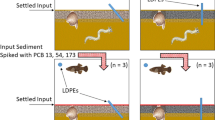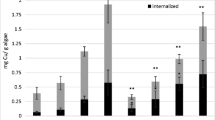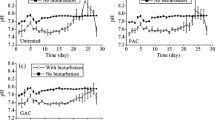Abstract
The control of algal growth in water reservoirs with copper-based algicides leads to elevated sediment Cu concentration and thus could affect long-term water quality. To assess the potential mobility of sediment-associated Cu, a study was conducted using samples from three drinking water reservoirs treated with Cutrine®, a copper triethanolamine complex algicide. Total Cu (CuT) in treated reservoir sediment ranged from 13.3 to 139.9 mg Cu kg−1 and was on average 1.5 times the level in streams (48 mg Cu kg−1) flowing into the reservoirs. Sediment CuT and algicide application history indicated the retention of 82–93% of the algicide Cu applied. Sequential extraction showed that Cu primarily accumulated in the residual fraction (60%), whereas the potentially mobile pools (water extractable: CuH2O, exchangeable: CuEX, organic bound) accounted for <10% of CuT. The leachable Cu fraction (extracted with 1 M acetic acid) also amounted to <9% of CuT and was related negatively to C/N and positively to H/C ratios of organic matter. In addition, these potentially mobile fractions were found to be related, not to total organic C, but to sediment respiration suggesting that the potentially mobile Cu fractions were primarily associated with aliphatic and readily biodegradable C (more so than total organic C). During a 2-year period without algicide treatment (that followed 4 years of repeated algicide applications to one of the studied reservoirs), mean dissolved Cu (micrograms per liter) in the reservoir (39.2) was similar to levels measured at locations upstream (43.3) and downstream (47.2) from the reservoir. These results indicate that the bulk of sediment Cu is associated with geochemically stable solid phases and thus should alleviate concerns about Cu transfer into the water column.







Similar content being viewed by others
References
Anderson, J. P. E. (1982). Soil respiration. In A. L. Page, R. H. Miller & D. R. Keeney (Eds.), Methods of soil analysis. Part II (2nd ed., pp. 831–872). Madison: American Society of Agronomy and Soil Science Society of America.
Barnett, R., & Tognazzini, M. (1987). Current methodology for the control of algae in surface reservoirs. American Water Resources Foundation, Report 905222.
Dollar, N. L., Souch, C., Filippelli, G. M., & Mastalerz, M. (2001). Chemical fractionation of metals in wetland sediments: Indiana Dunes National Lakeshore. Environmental Science & Technology, 35, 3608–3618.
EPA (1998). Toxicity characteristics leaching procedure (TCLP). Federal Register, 40 CFR, vol. 51, No. 256, Appendix 2, Part 268: 40643. United States Environmental Protection Agency (EPA).
EPA (2007). National primary drinking water regulations for lead and copper: short-term regulatory revisions and clarifications, 40 CFR Parts 141 and 142. United States Environmental Protection Agency (EPA).
Fuhrman, J. K., Zhang, H., Schroder, J. L., & Davis, R. L. (2005). Water-soluble phosphorus as affected by soil to extractant ratios, extraction times, and electrolyte. Communications in Soil Science and Plant Analysis, 36, 925–935.
Ghosh, K., & Schnitzer, M. (1980). Macromolecular structures of humic substances. Soil Science, 129, 266–276.
Gordon, E. S., Goni, M. A., Roberts, Q. N., Kineke, G. C., & Allison, M. A. (2001). Organic matter distribution and accumulation on the inner Louisiana shelf west of the Atchafalaya River. Continental Shelf Research, 21, 1691–1721.
Guggenberger, G., Glaser, G., & Zech, W. (1994). Heavy metal binding by hydrophobic and hydrophilic dissolved organic carbon in a spodosol A and B horizon. Water Air & Soil Pollution, 72, 111–127.
Han, F. X., Hargreaves, J. A., Kingery, W. L., Huggett, D. B., & Schlenk, D. K. (2001). Accumulation, distribution, and toxicity of copper in sediments of catfish ponds receiving periodic copper sulfate applications. Journal of Environmental Quality, 30, 912–919.
Harter, R. D., & Naidu, R. (1995). Role of metal-organic complexation in metal sorption by soils. Advances in Agronomy, 55, 219–263.
Haughey, M. A., Anderson, M. A., Whitney, R. D., Taylor, W. D., & Losee, R. F. (2000). Forms and fate of Cu in a source drinking water reservoir following CuSO4 treatment. Water Research, 34, 3440–3452.
Kabala, C., & Singh, R. R. (2001). Fractionation and mobility of copper, lead, and zinc in soil profiles in the vicinity of a copper smelter. Journal of Environmental Quality, 30, 485–492.
Knobeloch, L., Ziarnik, M., Howard, J., Theis, B., Farmer, D., Anderson, H., et al. (1994). Gastro-intestinal upsets associated with ingestion of copper-contaminated water. Environmental Health Perspectives, 102, 958–961.
Knox, A. S., Paller, M. H., Nelson, E. A., Specht, W. L., Halverson, N. V., & Gladden, J. B. (2006). Metal distribution and stability in constructed wetland sediment. Journal of Environmental Quality, 35, 1948–1959.
Kolak, J. J., Long, D. T., Beals, T. M., Eisenreich, S. J., & Swackhamer, D. J. (1998). Anthropogenic inventories and historical and present accumulation rates of copper in Great Lakes sediments. Applied Geochemistry, 13, 59–75.
Liu, R., & Zhao, D. (2007). The leachability, bioaccessibility, and speciation of Cu in the sediment of channel catfish ponds. Environmental Pollution, 147, 593–603.
Ma, H. Z., Allen, H. E., & Yin, Y. J. (2001). Characterization of isolated fractions of dissolved organic matter from natural waters and a wastewater effluent. Water Research, 35, 985–996.
McBride, M. B. (1994). Environmental chemistry of soils. Oxford: Oxford Univ. Press.
Moalla, S. M. N., Soltan, M. E., Rashed, M. N., & Fawzy, E. M. (2006). Evaluation of dilute hydrochloric acid and acid ammonium oxalate as extractants for some heavy metals from Nile River sediments. Chemical Ecology, 22, 313–327.
Narwal, R. P., Singh, B. R., & Salbu, B. (1999). Association of cadmium, zinc, copper, and nickel with components in naturally heavy metal-rich soils studied by parallel and sequential extractions. Communications in Soil Science &Plant Analysis, 30, 1209–1230.
Neupane, G., & Roberts, S. J. (2009). Quantitative comparison of heavy metals and As accumulation in agricultural and forest soils near Bowling Green, Ohio. Water Air & Soil Pollution, 197, 289–301.
Nriagu, J. O., & Pacyna, J. M. (1988). Quantitative assessment of worldwide contamination of air, water and soils by trace metals. Nature, 333, 134–139.
Perkins, S. M., Filippelli, G. M., & Souch, C. J. (2000). Airborne trace metal contamination of wetland sediments at Indiana Dunes National Lakeshore. Water Air & Soil Pollution, 122, 231–260.
Raftis, R. (2007). Internal cycling of phosphorus in an urban drinking water reservoir. M.S. thesis, Indiana University.
Ratasuk, P., Parkpian, P., Jugsujinda, A., & DeLaune, R. D. (2003). Factors governing adsorption and distribution of copper in Samut Prakarn coastal sediment, Thailand. Journal of Environmental Science & Health, Part A, 38, 1793–1810.
Sandberg, J., Wallinder, I. O., Leygraf, C., & Virta, M. (2007). Release and chemical speciation of copper from anti-fouling paints with different active copper compounds in artificial seawater. Materials & Corrosion, 58, 165–172.
Sauve, S., Dumestre, A., McBride, M., & Hendershot, W. (1998). Derivation of soil quality criteria using predicted chemical speciation of Pb2+ and Cu2+. Environmental Toxicology & Chemistry, 17, 1481–1489.
Seguin, V., Gagnon, C., & Courchesne, F. (2004). Changes in water extractable metals, pH and organic carbon concentrations at the soil–root interface of forested soils. Plant Soil, 260, 1–17.
Tack, F. M. G., Singh, S. P., & Verloo, M. G. (1999). Leaching behavior of Cd, Cu, Pb and Zn in surface soils derived from dredged sediments. Environmental Pollution, 106, 107–114.
Tedesco, L. P., Atekwana, E. A., Filippelli, G. F., Licht, K., Shrake, L. K., Hall, B. E., et al. (2003). Water quality and nutrient cycling in three Indiana watersheds and their reservoirs: Eagle Creek/Eagle Creek Reservoir, Fall Creek/Geist Reservoir, and Cicero Creek/Morse Reservoir. CEES publication 2003–01 (p. 163). Indianapolis: Central Indiana Water Resources Partnership.
Tessier, A., Campell, P. G. C., & Bisson, M. (1979). Sequential extraction procedure for the speciation of particulate trace metals. Analytical Chemistry, 51, 844–851.
Twiss, M. R., Rattan, K. J., Sherrell, R. M., & McKay, R. M. L. (2004). Sensitivity of phytoplankton to copper in Lake Superior. Journal of Great Lakes Research, 30, 245–255.
Van Hullebusch, E., Chatenet, P., Deluchat, V., Chazal, P. M., Froissard, D., Lens, P. N. L., et al. (2003). Fate and forms of Cu in a reservoir ecosystem following copper sulfate treatment (Saint Germain les Belles, France). Journal de Physique IV, 107, 1333–1336.
Xu, N., Ni, J. R., Sun, W. L., & Borthwick, A. G. L. (2007). Role of dissolved organic carbon in the cosorption of copper and phthalate esters onto Yellow River sediments. Chemosphere, 69, 1419–1427.
Acknowledgments
The author thanks Rosalice Buehrer, Jennifer Faust, Brandon Lewis, and Lora Shrake for their assistance in the laboratory. Robert E. Hall assisted with field sampling and preparation of maps. The study was funded through the Office of Professional Development Grant-in-Aid program (IUPUI). The 2003 sediment sampling program was funded by the central Indiana Water Resources Project, a research and development program funded by Veolia Water Indianapolis, LLC. Logistical support provided by the Center for Earth and Environmental Science (CEES) is gratefully acknowledged.
Author information
Authors and Affiliations
Corresponding author
Rights and permissions
About this article
Cite this article
Jacinthe, PA., Filippelli, G.M., Tedesco, L.P. et al. Distribution of Copper in Sediments from Fluvial Reservoirs Treated with Copper Triethanolamine Complex Algicide. Water Air Soil Pollut 211, 35–48 (2010). https://doi.org/10.1007/s11270-009-0278-3
Received:
Accepted:
Published:
Issue Date:
DOI: https://doi.org/10.1007/s11270-009-0278-3




